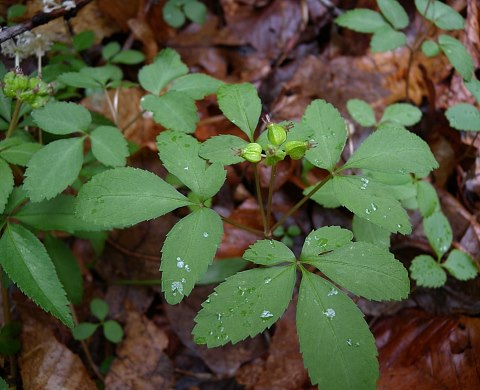Description: This perennial wildflower is 3-8" tall. It has an unbranched stem that terminates in a whorl of compound leaves and a single flowering stalk. The central stem is light green to dull red and hairless. The compound leaves are palmate with 3-5 leaflets. Individual leaflets are ¾-1½" long and about one-third as much across; they are oblanceolate or elliptic, serrated along their margins, and sessile (or nearly so). The upper surface of the leaves is medium green and hairless. The petioles of the compound leaves are ¾-2" long, light green to dull red, and hairless. The flowering stalk rises 1-3" above the leaves, terminating in a small umbel of white flowers about ¾" across. Like the central stem, it is light green to dull red and hairless. Individual flowers are about 1/8" (3 mm.) across, consisting of 5 white petals, a short white calyx, and 5 white stamens. The flowers of some plants are all staminate (male), while the flowers of other plants are perfect (male & female). Each staminate flower has a single non-functional style, while each perfect flower has 3 styles and a 3-celled ovary. Individual plants are capable of changing their gender from year-to-year. Like the flowers, the pedicels are also white.

The blooming
period occurs from mid- to late spring and lasts about 3 weeks. Umbels
of perfect flowers are replaced by small clusters of berries. These
berries are initially green, but they later become yellow; their
texture is rather dry. Each berry contains 2-3 seeds. The white seeds
are up to 3 mm. long and 2 mm. across; they are somewhat reniform in
shape and their surfaces are reticulated. The root system consists of a
globoid tuberous root about ½" across and it occasionally produces
rhizomes.
Cultivation:
The preference is light shade, moist conditions, and a rich loam with
abundant organic material. This wildflower develops quickly during the
spring, but dies down during early summer.
Range & Habitat:
Dwarf Ginseng is not known to occur in Illinois outside of cultivation
(see Distribution
Map), although it is native to both Wisconsin and Indiana in
areas that are closest to the NE section of the state. Dwarf Ginseng is
found in moist rich woodlands where deciduous trees are dominant and
the original ground flora is still intact.

Faunal
Associations:
Very little is known about floral-faunal relationships for this
species. The flowers are probably cross-pollinated by small bees and
flies.
Photographic Location:
A damp area of Goll Woods in NW Ohio.
Comments:
It's a pity that Dwarf Ginseng has not been found in Illinois: it is a
lovely wildflower. Its closest relative is probably Panax
quinquefolius (American Ginseng), which is a larger plant
that blooms later in the year. Unlike Dwarf Ginseng, American Ginseng
has leaflets with significant petiolules (small basal stalks) and its
berries are red, rather than yellow. While it is reportedly edible, the
tuberous root of Dwarf Ginseng is not used in herbal medicine. The
flavor of this root is supposed to be pungent.